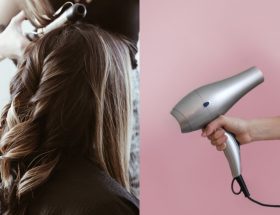This post may contain affiliate links. Any sales made through such links will reward me a small commission – at no extra cost for you!
Maintaining thick, voluminous hair is already a challenge. But this can be even more difficult when you’re struggling with thinning hair. Hair loss, also known as alopecia, affects 50% of adult women and 80% of adult men. For decades, many people accepted their hair loss as an unfortunate fact of life. But modern treatments are making it possible to regrow your hair.
What Causes Hair Loss?
While it can be emotionally devastating, hair loss is fairly common. There are many factors that can make you lose your hair. We’ll discuss some of these below:
Stress
Stress is one of the most common culprits of hair loss. Stress-induced hair loss, also known as telogen effluvium, can occur due to illness, surgery, emotional distress, childbirth, or crash dieting. When stressed, your body pushes an excessive number of your hair follicles prematurely into the telogen or resting phase. This makes your hair fall out in clumps.
Although a frightening condition, stress-induced hair loss is not permanent. Once your body recovers from the shock, your hair growth cycle will return to normal. In the meantime, you can find ways to regrow your hair quicker. Practice relaxation techniques, get enough sleep, and exercise regularly to calm your body and aid in its recovery.
Heredity
Another cause of hair loss is due to heredity. Hereditary hair loss, also known as androgenetic alopecia, can affect more than half of men and women by the time they reach 50. This condition involves both your genes and hormones. The hormone dihydrotestosterone (DHT) shrinks hair follicles. Over time, hair follicles produce hair so fine that it makes your scalp visible.
Unlike stress-induced hair loss, androgenetic alopecia is permanent. However, there are ways to regrow some of your hair and slow the progression of hair loss. Treatments for androgenetic alopecia work as long as you use them. If you stop using the treatments, you will lose all the hair you regrew while using the therapy.
Medical Conditions
There are many medical conditions that can cause hair loss. Some health disorders disrupt the normal hair growth cycle, while others destroy the hair follicles. The most common health conditions that make you lose hair include:
- Alopecia Areata – This is an autoimmune disorder that attacks hair follicles. It can cause patchy hair loss on the scalp and the rest of your body.
- Hypothyroidism – A disorder in which your thyroid gland does not produce enough thyroid hormones. It can cause hair thinning or full-blown hair loss.
- Iron Deficiency Anemia – This condition occurs when you lack red blood cells. It deprives your hair follicles of oxygen and nutrients, making your hair fall out.
- Polycystic Ovary Syndrome (PCOS) – A condition in which the ovaries produce too much androgens, or male sex hormones. This can make women lose hair on their head and grow hair elsewhere on the body.
5 Ways to Regrow Your Hair
While hair loss is an unfortunate condition many will have to endure, the good news is that there are plenty of treatments to regrow your hair. These include everything from DIY treatments and laser therapies to medications and surgery. Below, we will discuss some methods that can help regrow hair.
1. DIY Treatments
In some cases, all you need to regrow hair or, more importantly, preserve existing hair, is to take better care of your scalp. You’ll want to ensure your scalp is well-moisturized and isn’t dry or flaky so your hair follicles can function optimally. Some DIY treatments that can keep your scalp healthy include:
- Massaging the scalp – Scalp massages increase blood flow and nutrients to the hair follicles. In one study, scalp massage was shown to increase hair thickness.
- Moisturizing the scalp – Moisturizing the scalp is important to keep the hair follicles hydrated. Your hair follicles need moisture to work properly.
2. Herbal Remedies
There are several herbal remedies that have shown positive results when used to slow or stop hair loss. Some of these work to stimulate the hair follicles, increasing growth activity. Others increase hair density and slow the progression of hair loss. Here are some ways to regrow your hair naturally:
- Apply pure aloe vera gel to your scalp to soothe irritation and inflammation.
- Massage your scalp with coconut oil to enrich its microbiome.
- Take ginseng supplements to stimulate your hair follicles.
- Use onion juice on your scalp to promote hair growth.
3. Medications
While natural treatment options are the ideal way to regrow hair, they’re often inadequate in treating hair loss caused by heredity or medical conditions. This is when a physician may recommend medications to help regrow your hair. These can include the following:
- Minoxidil (Rogaine) – May slow or stop hair loss, but requires continuous use to maintain its effectiveness.
- Finasteride (Propecia) – This is specifically meant for men and may help with hair loss, but it can have some unwanted side effects, like a lower sex drive and an increased risk of prostate cancer.
- Spironolactone (Aldactone) – Blocks the action of androgen hormones that cause hair loss, helping regrow hair.
4. Hair Transplant Surgery
A permanent, albeit more invasive way to regrow hair is hair transplant surgery. In this procedure, a surgeon will remove sections of your scalp that have healthy hair follicles. These healthy sections are then divided into smaller pieces and transplanted onto balding areas of your scalp.
This procedure is meant to create healthy, hair-producing tissues all over your scalp and can lead to a nearly-full head of hair that looks natural. Hair transplant surgery can be an effective way to regrow your hair, but it may require many surgical sessions and can be uncomfortable.
5. Low-Level Laser Therapy
One of the most effective options for treating the early signs of hair thinning is low-level laser therapy (LLLT). LLLT uses gentle red laser light to regrow your hair. The red light energizes dormant hair follicles and increases blood flow to the scalp. This gives your hair follicles the energy and nutrients they need to support healthy hair growth.
LLLT technology is cleared by the FDA for treating pattern hair loss in men and women. Although a medical treatment, you can perform laser therapy on your own. There are many portable LLLT devices, such as laser combs and laser caps, that allow you to treat your hair from the comfort of your home. When used as directed, you can regrow your hair within 4-6 months.
Find a Treatment That Works for You
If you are finding more hair in your brush or shower drain than you normally do or have been diagnosed with alopecia, it might be the perfect time to start looking into ways to regrow hair. The first step to restoring your hair is to see a doctor. They can determine what is causing your hair loss and offer the right treatment.
No matter what is causing your hair loss, there are treatments that can help you restore some or all of your hair. So, keep an open mind and explore all the options available to you.
Written by Tess DiNapoli















